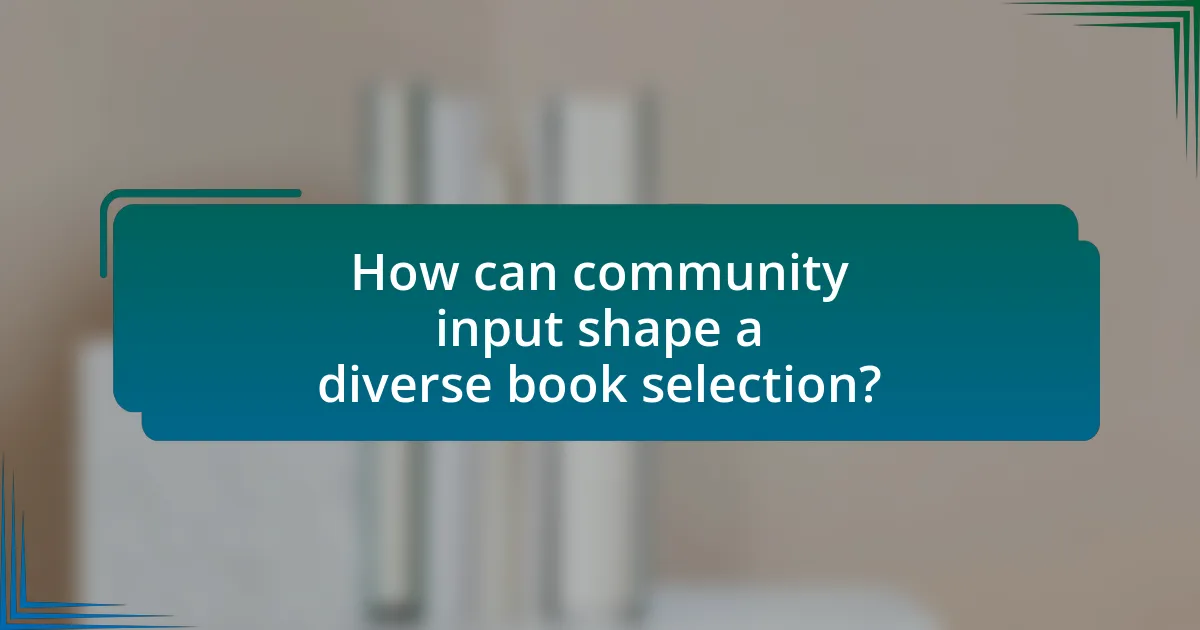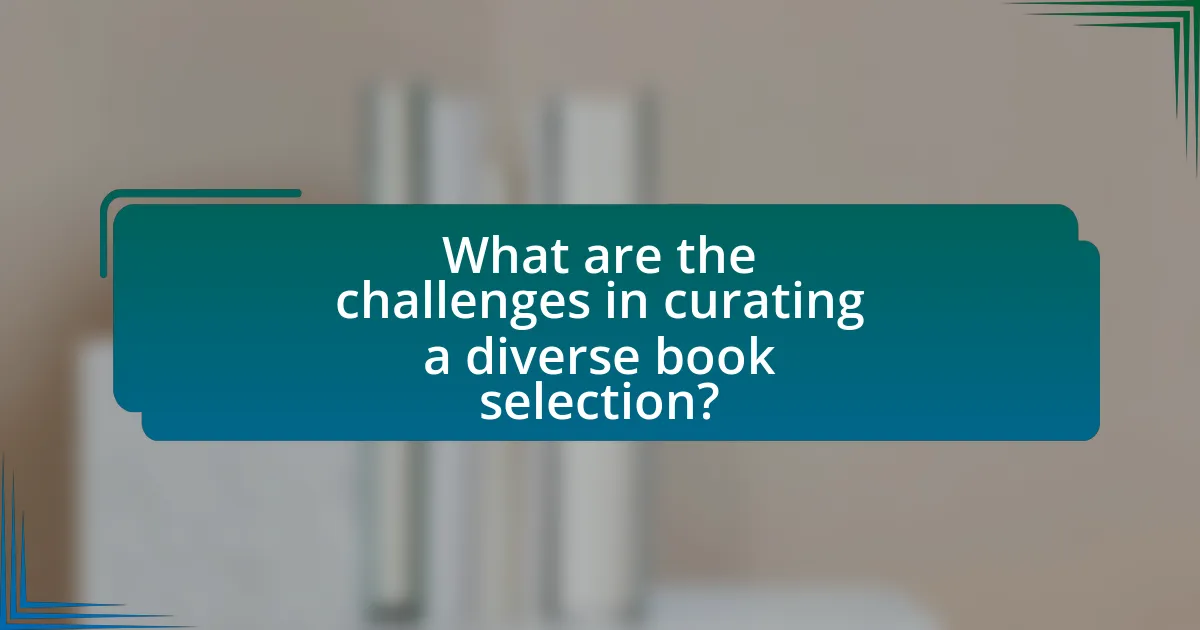Curating a diverse book selection involves the intentional choice of literature that reflects a wide array of voices, perspectives, and experiences across demographics such as race, gender, and culture. This practice is essential for promoting inclusivity and enhancing readers’ empathy and critical thinking skills. The article explores the importance of diversity in literature, the impact it has on readers, and the key elements necessary for a diverse selection. It also addresses challenges in the publishing industry, strategies for sourcing diverse authors, and the role of community engagement in shaping book collections. Additionally, it outlines best practices for maintaining diversity in literature, emphasizing the need for ongoing assessment and collaboration with local organizations.

What does it mean to curate a diverse book selection?
Curating a diverse book selection means intentionally choosing books that represent a wide range of voices, perspectives, and experiences across various demographics, including race, gender, sexuality, ability, and culture. This practice aims to provide readers with a more comprehensive understanding of the world and to promote inclusivity in literature. Research indicates that diverse literature can enhance empathy and critical thinking skills among readers, as it exposes them to different life experiences and viewpoints. For example, a study by the Cooperative Children’s Book Center found that in 2018, only 28% of children’s books published featured characters of color, highlighting the need for more diverse selections to reflect society accurately.
Why is diversity important in book selections?
Diversity is important in book selections because it ensures representation of various cultures, perspectives, and experiences, fostering empathy and understanding among readers. A diverse selection allows individuals to encounter narratives that reflect their own identities while also exposing them to viewpoints different from their own. Research indicates that diverse literature can enhance critical thinking and promote social awareness, as seen in studies like “The Importance of Diverse Literature” by the Cooperative Children’s Book Center, which highlights that children who read diverse books are more likely to develop a broader worldview.
How does diversity in literature reflect societal values?
Diversity in literature reflects societal values by showcasing a range of perspectives, experiences, and cultures that mirror the complexities of society. This representation allows readers to engage with different identities and social issues, fostering empathy and understanding. For instance, the rise of multicultural literature in the late 20th century, such as works by authors like Chimamanda Ngozi Adichie and Junot Díaz, illustrates how diverse narratives challenge dominant cultural norms and highlight marginalized voices. Studies indicate that exposure to diverse literature can enhance cultural competence and reduce prejudice, demonstrating literature’s role in shaping societal attitudes and values.
What impact does diverse literature have on readers?
Diverse literature significantly enhances readers’ empathy and cultural awareness. Exposure to varied perspectives fosters understanding of different life experiences, which can lead to increased compassion and reduced prejudice. Research indicates that reading diverse narratives can improve social cognition, as demonstrated in a study published in the journal “Science” by David Kidd and Emanuele Castano, which found that participants who read literary fiction showed greater empathy and social perception compared to those who read non-fiction or popular fiction. This impact underscores the importance of including diverse literature in reading selections to cultivate a more inclusive and understanding society.
What are the key elements of a diverse book selection?
The key elements of a diverse book selection include representation of various cultures, perspectives, and experiences. A diverse selection should encompass books authored by individuals from different racial, ethnic, and socioeconomic backgrounds, ensuring that readers encounter a wide range of voices and narratives. Additionally, it should include genres and themes that reflect varied life experiences, such as LGBTQ+ stories, disability representation, and historical accounts from multiple viewpoints. Research indicates that diverse literature can enhance empathy and understanding among readers, as highlighted in a study by the Cooperative Children’s Book Center, which found that only 28% of children’s books published in 2018 featured characters of color, underscoring the need for broader representation in literature.
How do genre and format contribute to diversity?
Genre and format contribute to diversity by providing varied perspectives and experiences that reflect different cultures, identities, and ideas. Different genres, such as fiction, non-fiction, poetry, and graphic novels, allow for the exploration of diverse themes and narratives, catering to a wide range of audiences. For instance, research by the Cooperative Children’s Book Center indicates that books featuring characters from diverse backgrounds are essential for fostering understanding and empathy among readers. Additionally, various formats, including audiobooks and e-books, increase accessibility, enabling a broader audience to engage with diverse content. This multifaceted approach ensures that literature represents a wide spectrum of voices and experiences, enriching the reading landscape.
What role do authors’ backgrounds play in diversity?
Authors’ backgrounds significantly influence diversity in literature by shaping the perspectives, themes, and narratives presented in their works. Diverse backgrounds, including ethnicity, culture, gender, and socioeconomic status, contribute to a broader range of experiences and viewpoints, enriching the literary landscape. For instance, a study by the Cooperative Children’s Book Center found that books by authors of color represented only 22% of children’s literature published in 2018, highlighting the need for more diverse voices to reflect varied experiences. This lack of representation can limit readers’ exposure to different cultures and ideas, underscoring the importance of including authors from diverse backgrounds in curating a comprehensive book selection.
How can one assess the current diversity of a book collection?
To assess the current diversity of a book collection, one should analyze the representation of various demographics, genres, and perspectives within the collection. This can be achieved by categorizing books based on author demographics such as race, gender, and nationality, as well as examining the themes and genres present. For instance, a study by the Cooperative Children’s Book Center found that in 2018, only 28% of children’s books published featured diverse characters, highlighting the need for a more inclusive selection. By comparing the collection against these metrics, one can identify gaps and areas for improvement in diversity.
What tools or methods can be used for evaluation?
Evaluation of diverse book selections can be conducted using tools such as surveys, focus groups, and data analytics. Surveys gather feedback from readers about their preferences and experiences, while focus groups facilitate in-depth discussions that reveal insights into community needs and interests. Data analytics can assess circulation statistics and demographic information to identify gaps in representation. These methods provide concrete evidence of community engagement and help ensure that the book selection reflects diverse voices and perspectives.
How can gaps in diversity be identified?
Gaps in diversity can be identified through a systematic analysis of representation across various demographics in literature. This involves assessing the authorship, themes, and characters in a book selection to determine if they reflect a wide range of cultural, racial, gender, and socioeconomic backgrounds. For instance, a study by the Cooperative Children’s Book Center found that in 2018, only 28% of children’s books published featured characters of color, highlighting a significant gap in representation. By comparing the demographics of the community or target audience with the diversity present in the book selection, one can pinpoint areas lacking adequate representation.
What strategies can be employed to curate a diverse book selection?
To curate a diverse book selection, one effective strategy is to actively seek out authors from various backgrounds, including different ethnicities, genders, and cultures. This approach ensures representation and broadens perspectives within the collection. Research indicates that diverse literature can enhance empathy and understanding among readers, as highlighted in the study “The Importance of Diverse Books” by the Cooperative Children’s Book Center, which found that only 28% of children’s books published in 2018 featured characters of color. Additionally, incorporating genres from various cultures, such as folklore, history, and contemporary narratives, can further enrich the selection. Engaging with community feedback and preferences also aids in identifying gaps in representation, ensuring that the curated selection resonates with a wider audience.
How can one source books from underrepresented authors?
One can source books from underrepresented authors by utilizing independent bookstores, online platforms that specialize in diverse literature, and literary organizations that promote marginalized voices. Independent bookstores often curate selections that highlight local and underrepresented authors, providing a direct avenue for discovery. Online platforms like Bookshop.org and websites such as We Need Diverse Books offer curated lists and recommendations specifically focused on diverse authors. Additionally, organizations like the African American Literature and Culture Society and the Asian American Writers’ Workshop actively promote and support underrepresented authors, often providing resources and lists of recommended readings. These methods ensure access to a wide range of voices and perspectives in literature.
What partnerships can enhance diversity in book selection?
Collaborations with diverse publishers, local cultural organizations, and community groups can enhance diversity in book selection. Diverse publishers often focus on underrepresented voices, providing access to a wider range of narratives and perspectives. For example, partnerships with organizations like We Need Diverse Books can help libraries and schools identify and acquire titles that reflect various cultures and experiences. Additionally, collaborating with local cultural organizations can facilitate events that promote diverse authors, further enriching the selection process. These partnerships not only broaden the scope of available literature but also foster community engagement and awareness of diverse stories.

How can community input shape a diverse book selection?
Community input can significantly shape a diverse book selection by reflecting the varied interests, backgrounds, and needs of its members. Engaging with community members through surveys, focus groups, and discussions allows curators to identify underrepresented voices and genres that resonate with the audience. For instance, libraries that implement community feedback mechanisms often report an increase in the inclusion of multicultural literature and authors from diverse backgrounds, which enhances the overall richness of their collections. This approach not only fosters inclusivity but also ensures that the book selection is relevant and representative of the community’s demographics and cultural narratives.
What methods can be used to gather community feedback?
Surveys and questionnaires are effective methods to gather community feedback. These tools allow organizations to collect quantitative and qualitative data from a broad audience, enabling them to understand community preferences and needs. For instance, a survey can include questions about preferred genres, authors, and themes, which directly inform the curation of a diverse book selection. Research indicates that 70% of respondents prefer providing feedback through online surveys due to their convenience and anonymity, making this method particularly valuable for engaging a wide demographic.
How can surveys and discussions inform book choices?
Surveys and discussions can inform book choices by gathering insights on reader preferences and interests. Surveys can quantitatively assess what genres, themes, or authors resonate with a specific audience, allowing curators to tailor selections that reflect these preferences. For instance, a survey might reveal that a majority of respondents prefer contemporary fiction over historical novels, guiding the selection process. Discussions, on the other hand, provide qualitative feedback, enabling deeper understanding of why certain books are favored, which can include factors like representation, relatability, or emotional impact. Engaging in discussions can also highlight overlooked titles that may not emerge in surveys, ensuring a more comprehensive and diverse book selection.
What role do local events play in promoting diverse literature?
Local events play a crucial role in promoting diverse literature by providing platforms for underrepresented authors and fostering community engagement with varied narratives. These events, such as book fairs, author readings, and literary festivals, create opportunities for diverse voices to be heard and celebrated, thereby increasing visibility for literature that reflects a wide range of cultural experiences. Research indicates that community-based literary events can enhance readership and appreciation for diverse genres, as they often include discussions, workshops, and interactive sessions that encourage dialogue around different perspectives. For instance, a study by the National Endowment for the Arts found that participation in literary events significantly boosts interest in reading diverse works, demonstrating the effectiveness of local gatherings in broadening literary horizons.
How can collaboration with local organizations enhance diversity?
Collaboration with local organizations enhances diversity by leveraging their unique insights and connections to underrepresented communities. These organizations often have established relationships and trust within diverse populations, which can facilitate access to a wider range of voices and perspectives. For instance, partnerships with local cultural groups can lead to the inclusion of authors from various backgrounds, enriching the book selection process. Research indicates that diverse teams produce more innovative solutions; thus, engaging with local organizations can lead to a more comprehensive and representative curation of literature, ultimately fostering inclusivity and understanding in the community.
What types of organizations should be considered for partnerships?
Organizations that should be considered for partnerships include educational institutions, community organizations, cultural institutions, and non-profits focused on literacy and diversity. Educational institutions, such as schools and universities, can provide access to diverse student populations and resources for promoting varied literature. Community organizations often engage with underrepresented groups, facilitating outreach and ensuring that diverse voices are included in book selections. Cultural institutions, like museums and libraries, can offer programs and events that highlight diverse authors and themes, enhancing community engagement with literature. Non-profits dedicated to literacy and diversity, such as Reading Is Fundamental, actively work to promote access to diverse books, making them valuable partners in curating a varied selection. These organizations collectively contribute to a broader understanding and appreciation of diverse literature, ensuring that book selections reflect a wide range of experiences and perspectives.
How can these collaborations be structured for maximum impact?
Collaborations can be structured for maximum impact by establishing clear objectives, defining roles, and fostering open communication among all stakeholders. Clear objectives ensure that all parties understand the goals of the collaboration, such as increasing access to diverse literature or enhancing community engagement. Defining roles allows each participant to contribute their unique strengths, whether in curation, outreach, or education. Open communication facilitates the sharing of ideas and feedback, which is essential for adapting strategies based on community needs. Research indicates that successful collaborations in educational settings often lead to improved outcomes when these elements are prioritized, as seen in initiatives like the Collaborative for Academic, Social, and Emotional Learning (CASEL), which emphasizes the importance of structured partnerships in achieving educational goals.

What are the challenges in curating a diverse book selection?
Curating a diverse book selection presents several challenges, including limited access to diverse authors, biases in publishing, and the difficulty of representing intersectional identities. Limited access arises because many publishers prioritize established authors, often overlooking voices from marginalized communities. Biases in publishing can lead to a lack of representation in marketing and distribution, which affects visibility and sales of diverse titles. Additionally, intersectionality complicates the curation process, as books may not adequately reflect the multifaceted experiences of individuals from various backgrounds, making it challenging to create a truly inclusive selection.
What biases might affect the curation process?
Curation processes can be affected by several biases, including confirmation bias, cultural bias, and availability bias. Confirmation bias occurs when curators favor information or books that align with their pre-existing beliefs, leading to a narrow selection. Cultural bias can influence the choice of books that reflect the curator’s own cultural background, potentially excluding diverse perspectives. Availability bias arises when curators prioritize books that are more readily accessible or familiar, rather than seeking out lesser-known works that may offer valuable insights. These biases can limit the diversity and inclusivity of the curated selection, ultimately impacting the representation of various voices and experiences in literature.
How can personal biases be recognized and mitigated?
Personal biases can be recognized and mitigated through self-reflection and structured feedback mechanisms. Self-reflection involves critically assessing one’s own beliefs and assumptions, often facilitated by tools such as journals or bias assessment questionnaires. Structured feedback mechanisms, such as peer reviews or diverse focus groups, provide external perspectives that can highlight blind spots in one’s thinking. Research indicates that individuals who engage in regular self-reflection and seek diverse viewpoints are more likely to identify and address their biases effectively, leading to more inclusive decision-making processes.
What systemic barriers exist in the publishing industry?
Systemic barriers in the publishing industry include lack of access to resources, bias in decision-making, and limited representation of marginalized voices. These barriers manifest through unequal opportunities for authors from diverse backgrounds, often resulting in fewer published works that reflect a variety of perspectives. For instance, a 2019 study by the Cooperative Children’s Book Center found that only 10% of children’s books published featured characters of color, highlighting the underrepresentation in the market. Additionally, industry gatekeepers, such as editors and agents, often favor established authors or those who fit a specific mold, perpetuating a cycle that excludes diverse narratives.
How can one overcome obstacles to achieving diversity?
To overcome obstacles to achieving diversity, one must actively seek out and include diverse voices in decision-making processes. This can be accomplished by implementing policies that prioritize representation, such as establishing diversity quotas or guidelines for selecting authors and topics. Research indicates that organizations with diverse leadership are 35% more likely to outperform their peers, highlighting the importance of inclusive practices. Additionally, creating partnerships with diverse communities can provide valuable insights and resources, further enhancing the diversity of book selections.
What resources are available for curators facing challenges?
Curators facing challenges can access various resources, including professional organizations, online platforms, and educational programs. Organizations such as the American Library Association (ALA) provide guidelines and support for curators in selecting diverse materials. Online platforms like Project MUSE and JSTOR offer access to scholarly articles and research on diversity in literature. Additionally, educational programs and workshops focused on diversity in curation can enhance curatorial skills and knowledge. These resources collectively empower curators to effectively address challenges in creating diverse book selections.
How can ongoing education improve diversity efforts?
Ongoing education can improve diversity efforts by equipping individuals with the knowledge and skills necessary to understand and appreciate diverse perspectives. This education fosters awareness of systemic inequalities and cultural differences, which is essential for creating inclusive environments. For instance, studies show that organizations that prioritize diversity training see a 35% increase in employee engagement and a 20% improvement in team performance, highlighting the tangible benefits of informed diversity initiatives. By continuously educating individuals about diversity, organizations can cultivate a more inclusive culture that values and respects all voices.
What are some best practices for maintaining a diverse book selection?
To maintain a diverse book selection, regularly assess and update the collection to include a wide range of voices, genres, and perspectives. This practice ensures representation of various cultures, identities, and experiences, which is essential for fostering inclusivity. Research indicates that diverse literature enhances empathy and understanding among readers, as highlighted in the study “The Importance of Diverse Literature” by the American Library Association, which emphasizes the role of diverse books in promoting social awareness and cultural competence. Additionally, engaging with community feedback and collaborating with local organizations can help identify gaps in representation and inform future acquisitions.
How can regular reviews and updates ensure ongoing diversity?
Regular reviews and updates ensure ongoing diversity by systematically evaluating and refreshing the book selection to reflect a wide range of voices and perspectives. This process allows curators to identify gaps in representation, ensuring that marginalized authors and diverse genres are included. For instance, a study by the Cooperative Children’s Book Center found that in 2018, only 28% of children’s books published featured characters of color, highlighting the need for continuous assessment to improve diversity. By implementing regular reviews, organizations can adapt to changing societal norms and reader interests, thereby fostering an inclusive literary environment.
What role does community engagement play in sustaining diversity?
Community engagement is essential for sustaining diversity as it fosters inclusive dialogue and collaboration among various cultural groups. By actively involving community members in decision-making processes, organizations can better understand and address the unique needs and perspectives of diverse populations. Research indicates that communities with high levels of engagement experience greater social cohesion and representation, which in turn supports the preservation of cultural identities. For instance, a study by the National Endowment for the Arts highlights that community-based initiatives lead to increased participation in cultural activities, thereby enhancing the visibility and appreciation of diverse voices.


